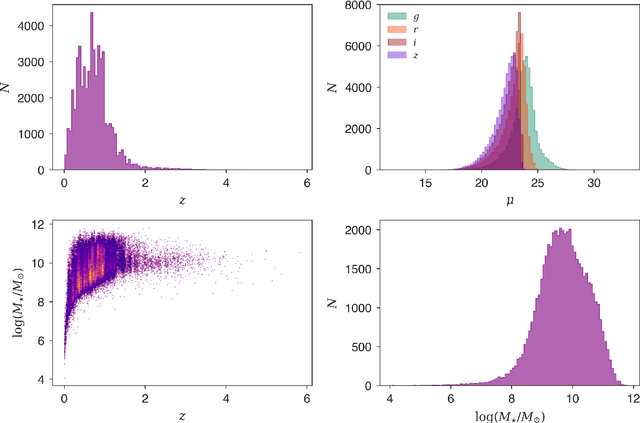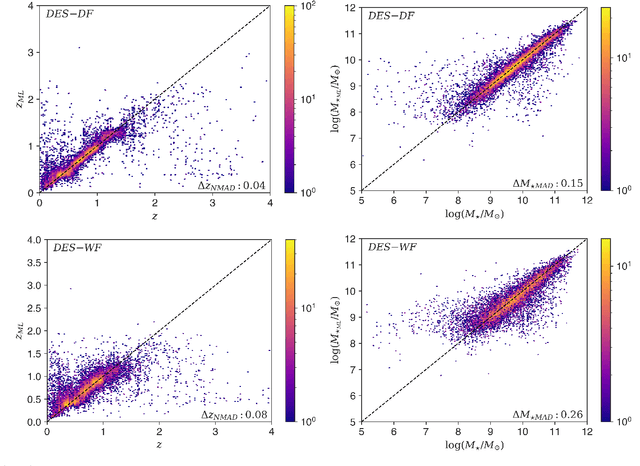M. Carrasco Kind
Department of Astronomy, University of Illinois at Urbana-Champaign
A machine learning approach to galaxy properties: Joint redshift - stellar mass probability distributions with Random Forest
Dec 10, 2020



Abstract:We demonstrate that highly accurate joint redshift - stellar mass PDFs can be obtained using the Random Forest (RF) machine learning (ML) algorithm, even with few photometric bands available. As an example, we use the Dark Energy Survey (DES), combined with the COSMOS2015 catalogue for redshifts and stellar masses. We build two ML models: one containing deep photometry in the $griz$ bands, and the second reflecting the photometric scatter present in the main DES survey, with carefully constructed representative training data in each case. We validate our joint PDFs for $10,699$ test galaxies by utilising the copula probability integral transform (copPIT) and the Kendall distribution function, and their univariate counterparts to validate the marginals. Benchmarked against a basic set-up of the template-fitting code BAGPIPES, our ML-based method outperforms template fitting on all of our pre-defined performance metrics. In addition to accuracy, the RF is extremely fast, able to compute joint PDFs for a million galaxies in just over $2$ hours with consumer computer hardware. Such speed enables PDFs to be derived in real-time within analysis codes, solving potential storage issues. As part of this work we have developed GALPRO, a highly intuitive and efficient Python package to rapidly generate multivariate PDFs on-the-fly. GALPRO is documented and available for researchers to use in their cosmology and galaxy evolution studies at https://galpro.readthedocs.io/.
SOMz: photometric redshift PDFs with self organizing maps and random atlas
Dec 18, 2013



Abstract:In this paper we explore the applicability of the unsupervised machine learning technique of Self Organizing Maps (SOM) to estimate galaxy photometric redshift probability density functions (PDFs). This technique takes a spectroscopic training set, and maps the photometric attributes, but not the redshifts, to a two dimensional surface by using a process of competitive learning where neurons compete to more closely resemble the training data multidimensional space. The key feature of a SOM is that it retains the topology of the input set, revealing correlations between the attributes that are not easily identified. We test three different 2D topological mapping: rectangular, hexagonal, and spherical, by using data from the DEEP2 survey. We also explore different implementations and boundary conditions on the map and also introduce the idea of a random atlas where a large number of different maps are created and their individual predictions are aggregated to produce a more robust photometric redshift PDF. We also introduced a new metric, the $I$-score, which efficiently incorporates different metrics, making it easier to compare different results (from different parameters or different photometric redshift codes). We find that by using a spherical topology mapping we obtain a better representation of the underlying multidimensional topology, which provides more accurate results that are comparable to other, state-of-the-art machine learning algorithms. Our results illustrate that unsupervised approaches have great potential for many astronomical problems, and in particular for the computation of photometric redshifts.
 Add to Chrome
Add to Chrome Add to Firefox
Add to Firefox Add to Edge
Add to Edge